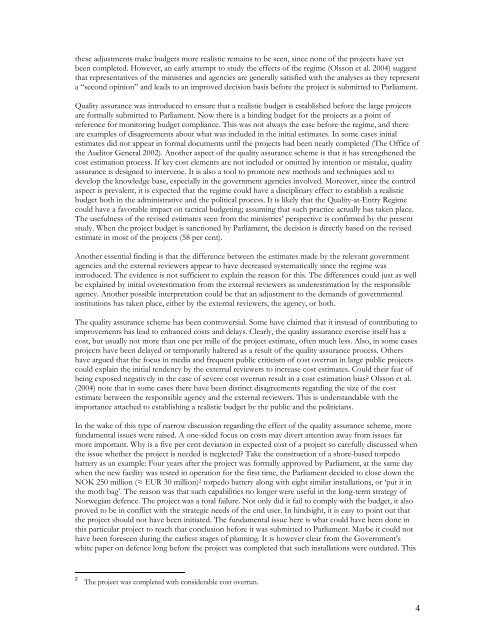Link to thesis. - Concept - NTNU
Link to thesis. - Concept - NTNU
Link to thesis. - Concept - NTNU
- No tags were found...
Create successful ePaper yourself
Turn your PDF publications into a flip-book with our unique Google optimized e-Paper software.
these adjustments make budgets more realistic remains <strong>to</strong> be seen, since none of the projects have yetbeen completed. However, an early attempt <strong>to</strong> study the effects of the regime (Olsson et al. 2004) suggestthat representatives of the ministries and agencies are generally satisfied with the analyses as they representa “second opinion” and leads <strong>to</strong> an improved decision basis before the project is submitted <strong>to</strong> Parliament.Quality assurance was introduced <strong>to</strong> ensure that a realistic budget is established before the large projectsare formally submitted <strong>to</strong> Parliament. Now there is a binding budget for the projects as a point ofreference for moni<strong>to</strong>ring budget compliance. This was not always the case before the regime, and thereare examples of disagreements about what was included in the initial estimates. In some cases initialestimates did not appear in formal documents until the projects had been nearly completed (The Office ofthe Audi<strong>to</strong>r General 2002). Another aspect of the quality assurance scheme is that it has strengthened thecost estimation process. If key cost elements are not included or omitted by intention or mistake, qualityassurance is designed <strong>to</strong> intervene. It is also a <strong>to</strong>ol <strong>to</strong> promote new methods and techniques and <strong>to</strong>develop the knowledge base, especially in the government agencies involved. Moreover, since the controlaspect is prevalent, it is expected that the regime could have a disciplinary effect <strong>to</strong> establish a realisticbudget both in the administrative and the political process. It is likely that the Quality-at-Entry Regimecould have a favorable impact on tactical budgeting; assuming that such practice actually has taken place.The usefulness of the revised estimates seen from the ministries’ perspective is confirmed by the presentstudy. When the project budget is sanctioned by Parliament, the decision is directly based on the revisedestimate in most of the projects (58 per cent).Another essential finding is that the difference between the estimates made by the relevant governmentagencies and the external reviewers appear <strong>to</strong> have decreased systematically since the regime wasintroduced. The evidence is not sufficient <strong>to</strong> explain the reason for this. The differences could just as wellbe explained by initial overestimation from the external reviewers as underestimation by the responsibleagency. Another possible interpretation could be that an adjustment <strong>to</strong> the demands of governmentalinstitutions has taken place, either by the external reviewers, the agency, or both.The quality assurance scheme has been controversial. Some have claimed that it instead of contributing <strong>to</strong>improvements has lead <strong>to</strong> enhanced costs and delays. Clearly, the quality assurance exercise itself has acost, but usually not more than one per mille of the project estimate, often much less. Also, in some casesprojects have been delayed or temporarily haltered as a result of the quality assurance process. Othershave argued that the focus in media and frequent public criticism of cost overrun in large public projectscould explain the initial tendency by the external reviewers <strong>to</strong> increase cost estimates. Could their fear ofbeing exposed negatively in the case of severe cost overrun result in a cost estimation bias? Olsson et al.(2004) note that in some cases there have been distinct disagreements regarding the size of the costestimate between the responsible agency and the external reviewers. This is understandable with theimportance attached <strong>to</strong> establishing a realistic budget by the public and the politicians.In the wake of this type of narrow discussion regarding the effect of the quality assurance scheme, morefundamental issues were raised. A one-sided focus on costs may divert attention away from issues farmore important. Why is a five per cent deviation in expected cost of a project so carefully discussed whenthe issue whether the project is needed is neglected? Take the construction of a shore-based <strong>to</strong>rpedobattery as an example: Four years after the project was formally approved by Parliament, at the same daywhen the new facility was tested in operation for the first time, the Parliament decided <strong>to</strong> close down theNOK 250 million (≈ EUR 30 million) 2 <strong>to</strong>rpedo battery along with eight similar installations, or ‘put it inthe moth bag’. The reason was that such capabilities no longer were useful in the long-term strategy ofNorwegian defence. The project was a <strong>to</strong>tal failure. Not only did it fail <strong>to</strong> comply with the budget, it alsoproved <strong>to</strong> be in conflict with the strategic needs of the end user. In hindsight, it is easy <strong>to</strong> point out thatthe project should not have been initiated. The fundamental issue here is what could have been done inthis particular project <strong>to</strong> reach that conclusion before it was submitted <strong>to</strong> Parliament. Maybe it could nothave been foreseen during the earliest stages of planning. It is however clear from the Government’swhite paper on defence long before the project was completed that such installations were outdated. This2The project was completed with considerable cost overrun.4
















